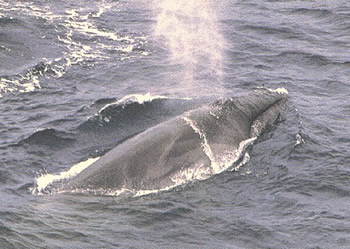Sei whale
(Balaenoptera borealis)

Geographic
distribution
The Sei
Whale live in every sea in the world. These animals occupy
temperate and subpolar regions in the summer and migrate
to sub-tropical waters during the winter.
Characteristics
Sei whales
are smaller than the fin whales. The average length of males
is 13 m, females are larger. Sei whales weigh between 20-25
tonnes.
They have a compressed tail and short pectoral fins. The dorsal fin ranges
in height from 25 to 61 cm, is slightly hooked and is located about two-thirds
back along the body. The body is dark steel grey with irregular white markings
ventrally. Each side of the upper part of the mouth contains about 400 baleen
plates.
Behavior
These animals
feed on the surface of the water by trapping small fish and
plankton in their baleen plates. A Sei whale eats about 900
kilograms of food every day.
They live in large aggregations and are very fast, swimming at speeds of up
to 50 kilometers per hour, but they are not good divers .

